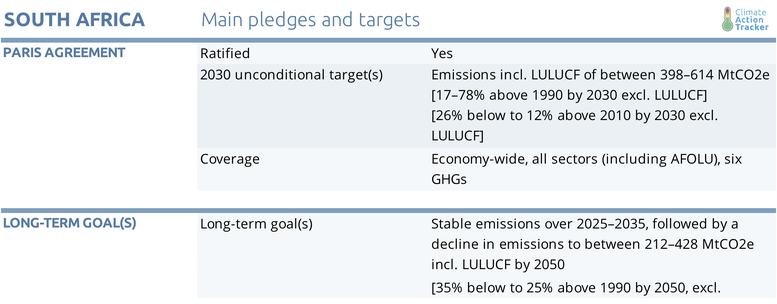Country summary
Overview
The South African government under recently re-elected President Cyril Ramaphosa released the long-awaited draft of its Integrated Resource Plan (IRP 2018) in August 2018, setting out a new direction in energy sector planning. The plan includes a shift away from coal, increased adoption of renewables and gas, and an end to the expansion of nuclear power. The energy minister has now announced that the update will soon be concluded and approved by Parliament.
The revised plan would mark a major shift in energy policy, which is remarkable for a coal-dominated country like South Africa. It aims to decommission a total of 35 GW (of 42 GW currently operating) of coal-fired power capacity from state-owned coal and utility giant Eskom by 2050. However, it would still complete nearly 6 GW of costly coal capacity currently under construction and commission another 1 GW of new coal capacity by 2030.
The plan also proposes a significant increase in renewables-based generation from wind and solar as well as gas-based generation capacity by 2030 (additional 8.1 GW for wind, 5.7 GW for solar and 8.1 GW for gas by 2030) and beyond, with no further new nuclear capacity being procured.
Implementing the IRP update of 2018 could bring South Africa close to meeting the upper range of its 2030 NDC target. The implementation of the IRP update of 2018 would constitute significant progress in the transformation of the South African energy sector. However, we rate South Africa’s NDC target as “Highly Insufficient” based on the upper end of the NDC range. In this context, South Africa can consider downward revising its target for 2030 to be resubmitted to the UNFCCC as part of the Paris Agreement’s ambition raising cycle of 2020. To be in line with the Paris Agreement goals for mitigation, South Africa would further need to adopt more ambitious actions by 2050, beyond the proposed IRP update, such as expanding renewable energy capacity beyond 2030, fully phasing out coal-fired power generation by mid-century, and substantially limiting unabated natural gas use.
Directly after the recent elections in May 2019, Energy Minister Jeff Radebe announced that the IRP update will be concluded ‘very shortly’ and be approved by the Cabinet.
The previous two proposed IRP updates in 2013 and 2016 were never adopted by former president Jacob Zuma’s Cabinet. The South African Parliament finally approved a carbon tax in February 2019 after two years of consultations, although its immediate impact is likely to be limited given tax exemptions for up to 95% of emissions during the first phase until 2022.
South Africa’s Nationally Determined Contribution (NDC) contains a target to limit greenhouse gas (GHG) emissions including land use, land use change and forestry (LULUCF) to between 398 and 614 MtCO2e over the period 2025–2030. This target is equivalent to a 19–82% increase on 1990 levels excluding LULUCF.
South Africa’s NDC is consistent with its pledge under the Copenhagen Accord, which proposed emissions reductions below business-as-usual (BAU) levels, incl. LULUCF, by 34% in 2020 and 42% in 2025. This represents a 17–69% increase in emissions excluding LULUCF in 2020 and a 17–78% increase in 2025 on 1990 levels, excluding LULUCF.
Although South Africa is one of the few countries that has put forward absolute emission reduction targets in their NDC, we still rate this target “Highly insufficient”.


Our analysis shows that under its currently implemented policies and continued low economic growth, South Africa will reach the less ambitious end of its emission reduction targets in 2020 and 2025, but will not meet its mitigation target in 2030.
Emissions projections for 2030 are 16 MtCO2e higher than the upper end of the target for 2030. The CAT’s projections show South Africa’s emissions trajectory under its implemented policies in 2020 and 2030 which are expected to increase by 68% and 82%, respectively, on 1990 levels excluding LULUCF. If South Africa’s economy were to grow again, emissions levels up to 2030 may be expected to increase.
In the first quarter of 2019, South Africa experienced several instances of rolling blackouts instituted by Eskom, South Africa’s state-owned grid operator and owner of most South African coal-fired power plants. These recent operational problems add to overall concerns on reliability and sustainability of South Africa’s electricity supply in the future.
Uncertainty around Eskom’s financial solvency also remains a contributing factor to overall planning uncertainty and ongoing delays in progress on renewable capacity extension. In this context, President Ramaphosa appointed an Eskom Sustainability Task Team in December 2018 to provide recommendations to address Eskom’s many operational, structural, and technical challenges.
Further analysis
Latest publications
Stay informed
Subscribe to our newsletter




